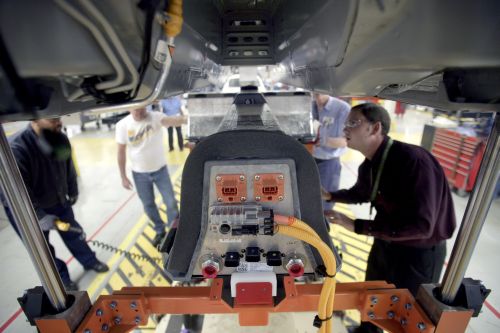 Some assembly required.GM.comAt one of our news meetings last week, I mentioned a story I had seen. “GM says the Chevy Volt will get 230 miles per gallon,” I told my fellow editors. The number struck me funny because it was ludicrously far beyond any current mpg rating, and because GM acknowledged that the Volt, due in late 2010, would be difficult to recharge given current infrastructure. It’s as if you had a pony that delivered lollipops door to door, except it didn’t have anywhere to buy them. But to a couple of staffers, it was funny for a whole different reason: “Miles per gallon of what?” they asked. “It’s electric!”
Some assembly required.GM.comAt one of our news meetings last week, I mentioned a story I had seen. “GM says the Chevy Volt will get 230 miles per gallon,” I told my fellow editors. The number struck me funny because it was ludicrously far beyond any current mpg rating, and because GM acknowledged that the Volt, due in late 2010, would be difficult to recharge given current infrastructure. It’s as if you had a pony that delivered lollipops door to door, except it didn’t have anywhere to buy them. But to a couple of staffers, it was funny for a whole different reason: “Miles per gallon of what?” they asked. “It’s electric!”
The Volt does use some gas, and the 230 mpg figure is based on some fancy-footwork math. But as this Time article points out, a more realistic measurement for the new generation of vehicles might be kilowatt-hours per mile or even, when we get really high-tech, miles per kilogram of hydrogen.
I wasn’t the only one intrigued by the car company’s hype. Hundreds of stories repeated GM’s claim — breathlessly at first, then with a creeping note of skepticism, then with level-headed analysis. It didn’t take long for the EPA, which faces the unenviable task of figuring out how to develop fuel-economy measurements for plug-in electric hybrids, to clarify that it had not actually tested a Volt and couldn’t confirm the 230 mpg figure.
For me, the most entertaining part of the whole episode was this quote from a blog entry by GM Vice Chair Bob Lutz: “I’ve said before that Volt is like our moon shot, and I stand by that statement. It’s exactly like a moon shot, if the lunar landing module were getting 230 miles per gallon.”
Exactly!
So to today’s “moon shot”: GM is floating the idea that it might produce a $4,000 compact car. The model would likely be made and sold in Asia, though VP of International Operations Nick Reilly said the company can’t scooch down as low as the $2,500 Tata Nano because of emissions standards, among other reasons. This news, too, is being greeted fairly warmly; writes Derek Thompson in The Atlantic: “[Whether or not the car sells in the U.S.], it’s nice to see GM trying to compete with emerging market auto makers, because it tells me that somebody is serious about making GM an auto company that’s thinking globally and long term.”
Is that what we’re seeing — the transformation of a near-dinosaur into a far-sighted global giant? Or are we watching that dinosaur thrash around helplessly in a shady swamp, occasionally spitting out shiny driblets of PR that make the media go wild? Can a dinosaur make a moon shot and survive?



